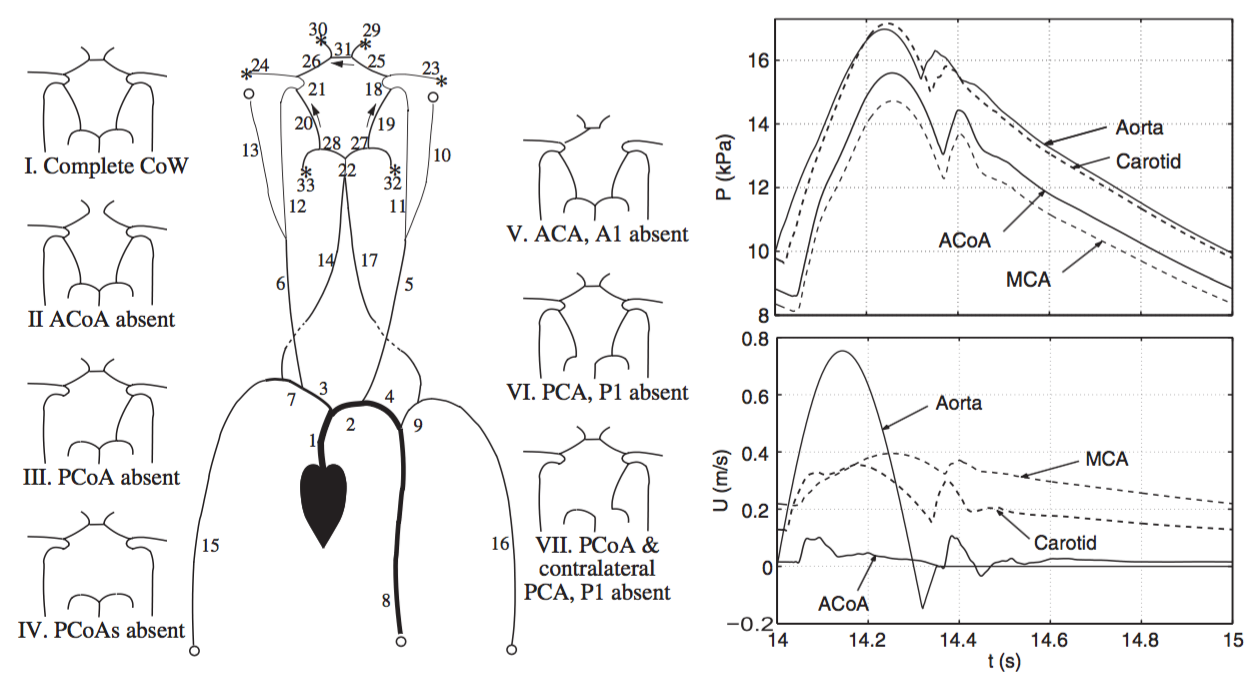Haemodynamic Effects of Anatomical Variations and Occlusions on Cerebral Flows
The brain is particularly dependent on the cerebral circulation since it has a high metabolic rate and is very sensitive to ischaemia (insufficient blood supply). Sufficient blood supply to the brain is maintained by a network of collateral vessels, the circle of Willis (CoW) being the main collateral pathway, and a precise system of auto-regulation by vasodilatation and vasoconstriction. The risk of cerebral ischaemia increases when sudden obstructions in the flow occur, particularly during surgical procedures such as carotid endarterectomy (surgical incision to remove plaque in patients with a severe stenosis), angioplasty (balloon expansion) and stenting (introduction of a mesh to keep the lumen open after angioplasty).
 We produced a novel model of pulsatile blood flow in the cerebral circulation to study the effects on cerebral flows of anatomical variations of the CoW (a ring-like arterial structure located at the base of the brain) and occlusions of the neck arteries. The model, which accounts for cerebral flow auto-regulation (Int J Numer Meth Fluids, 2008), was verified qualitatively by comparison against in vivo velocity waves measured by Doppler ultrasound (J Biomech, 2007).
We produced a novel model of pulsatile blood flow in the cerebral circulation to study the effects on cerebral flows of anatomical variations of the CoW (a ring-like arterial structure located at the base of the brain) and occlusions of the neck arteries. The model, which accounts for cerebral flow auto-regulation (Int J Numer Meth Fluids, 2008), was verified qualitatively by comparison against in vivo velocity waves measured by Doppler ultrasound (J Biomech, 2007).
 The model allows us to better understand the haemodynamic factors that increase the risk of cerebral ischaemia during surgical procedures in the afferent arteries of the CoW. It has identified the worst CoW anatomical variation in terms of restoring normal cerebral flows after a sudden carotid occlusion: a circle without the first segment of the contralateral anterior cerebral artery (Int J Numer Meth Fluids, 2008). It has also highlighted the anterior communicating artery (ACoA) as a critical collateral pathway to compensate for carotid occlusions (J Biomech, 2007).
The model allows us to better understand the haemodynamic factors that increase the risk of cerebral ischaemia during surgical procedures in the afferent arteries of the CoW. It has identified the worst CoW anatomical variation in terms of restoring normal cerebral flows after a sudden carotid occlusion: a circle without the first segment of the contralateral anterior cerebral artery (Int J Numer Meth Fluids, 2008). It has also highlighted the anterior communicating artery (ACoA) as a critical collateral pathway to compensate for carotid occlusions (J Biomech, 2007).
 The model allowed us to associate frequent anatomical variations of the CoW with specific cerebral blood flow patterns that can be detected by transcranial colour-coded duplex ultrasonography, providing a theoretical basis for inferring the CoW anatomy from pulse wave analysis (J Biomech, 2007). The model has also been used to show that the collateral pathways of a complete CoW can recruit blood to supply the increase in demand during regional stimulation of the brain without depleting blood flow from other areas of the brain (J Biomech Eng, 2015).
The model allowed us to associate frequent anatomical variations of the CoW with specific cerebral blood flow patterns that can be detected by transcranial colour-coded duplex ultrasonography, providing a theoretical basis for inferring the CoW anatomy from pulse wave analysis (J Biomech, 2007). The model has also been used to show that the collateral pathways of a complete CoW can recruit blood to supply the increase in demand during regional stimulation of the brain without depleting blood flow from other areas of the brain (J Biomech Eng, 2015).
 We produced a novel model of pulsatile blood flow in the cerebral circulation to study the effects on cerebral flows of anatomical variations of the CoW (a ring-like arterial structure located at the base of the brain) and occlusions of the neck arteries. The model, which accounts for cerebral flow auto-regulation (Int J Numer Meth Fluids, 2008), was verified qualitatively by comparison against in vivo velocity waves measured by Doppler ultrasound (J Biomech, 2007).
We produced a novel model of pulsatile blood flow in the cerebral circulation to study the effects on cerebral flows of anatomical variations of the CoW (a ring-like arterial structure located at the base of the brain) and occlusions of the neck arteries. The model, which accounts for cerebral flow auto-regulation (Int J Numer Meth Fluids, 2008), was verified qualitatively by comparison against in vivo velocity waves measured by Doppler ultrasound (J Biomech, 2007).
 The model allowed us to associate frequent anatomical variations of the CoW with specific cerebral blood flow patterns that can be detected by transcranial colour-coded duplex ultrasonography, providing a theoretical basis for inferring the CoW anatomy from pulse wave analysis (J Biomech, 2007). The model has also been used to show that the collateral pathways of a complete CoW can recruit blood to supply the increase in demand during regional stimulation of the brain without depleting blood flow from other areas of the brain (J Biomech Eng, 2015).
The model allowed us to associate frequent anatomical variations of the CoW with specific cerebral blood flow patterns that can be detected by transcranial colour-coded duplex ultrasonography, providing a theoretical basis for inferring the CoW anatomy from pulse wave analysis (J Biomech, 2007). The model has also been used to show that the collateral pathways of a complete CoW can recruit blood to supply the increase in demand during regional stimulation of the brain without depleting blood flow from other areas of the brain (J Biomech Eng, 2015).